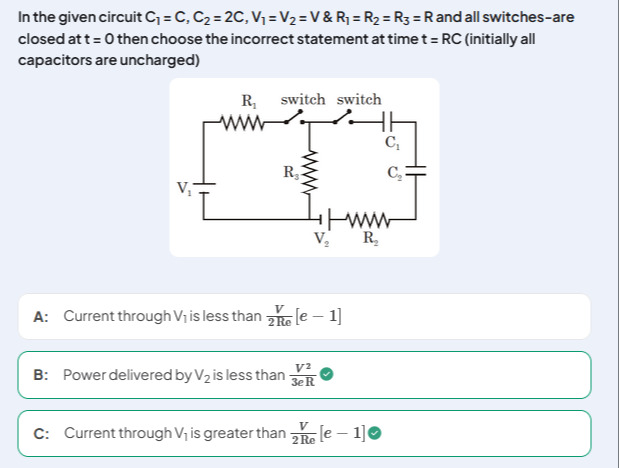Question
Question: In the given circuit C₁ = C, C₂ = 2C, V₁ = V₂ = V & R₁ = R₂ = R₃ = R and all switches-are closed at ...
In the given circuit C₁ = C, C₂ = 2C, V₁ = V₂ = V & R₁ = R₂ = R₃ = R and all switches-are closed at t = 0 then choose the incorrect statement at time t = RC (initially all capacitors are uncharged)

Current through V₁ is less than 2ReV[e−1]
Power delivered by V₂ is less than 3eRV2
Current through V₁ is greater than 2ReV[e−1]
Incorrect statements are A and B.
Solution
We will show that if we view the circuit as a single‐loop network so that the two sources “assist” each other (i.e. their EMFs add up to 2V), then the three resistors R₁, R₂ and R₃ (all equal to R) lie in series and the two capacitors (of capacitances C and 2C in series) have an equivalent capacitance
Ceq=C+2CC⋅2C=32C.
Thus the overall time‐constant is
τ=(R1+R2+R3)⋅Ceq=(3R)⋅32C=2RC.
For a standard RC–circuit the current (if the net emf is 2V) is I(t)=3R2V⋅eτ−t.
At t = RC we have I(RC)=3R2V⋅e2RC−RC=3R2V⋅e2−1.
Numerically, since e2−1≈0.6065, I(RC)≈3R2V⋅0.6065≈0.4043⋅RV.
Now notice that the “benchmark” given in options A and C is
2eRV⋅(e−1).
Since e ≈ 2.718, e – 1 ≈ 1.718 so that 2eRV⋅(e−1)≈5.436RV⋅1.718≈0.316⋅RV.
Thus we have
I(RC)≈0.4043RV>0.316RV.
In other words, the current coming from V₁ is greater than the given benchmark value. Therefore:
- Statement A (“Current through V₁ is less than …”) is false.
- Statement C (“Current through V₁ is greater than …”) is correct.
Next, the power supplied by source V₂ (which—since the circuit is in series—has the same current I flowing through it) is
P2=V⋅I(RC)≈V⋅(0.4043⋅RV)=0.4043⋅RV2.
But the option B claims that P2<3eRV2.
Since 3e ≈ 8.154, we have 3eRV2≈0.1226⋅RV2. Clearly 0.4043⋅RV2 is not less than 0.1226⋅RV2. Thus statement B is also false.
So, the incorrect statements (the “wrong” ones) are A and B.
Summary of Core Steps:
- The loop has three resistors (3R) and the series combination of C and 2C gives Ceq=32C so that τ = 2RC.
- With net emf 2V, the transient current is I(t)=3R2V⋅e2RC−t. At t = RC, I≈0.4043⋅RV.
- The given benchmark current is 2eRV(e–1)≈0.316⋅RV. Thus statement A is false and C true.
- Also, power from V₂ is V⋅I≈0.4043⋅RV2 which is not less than 3eRV2≈0.1226RV2. So B is false.
